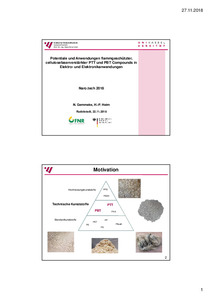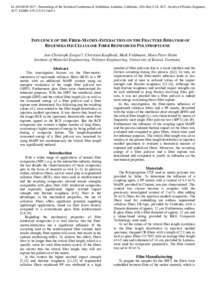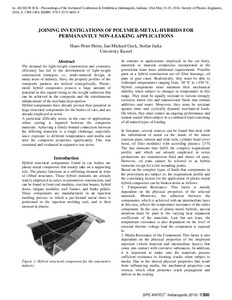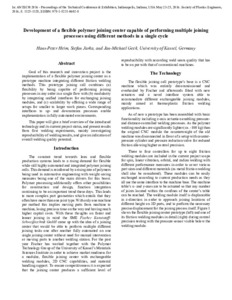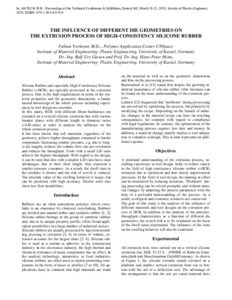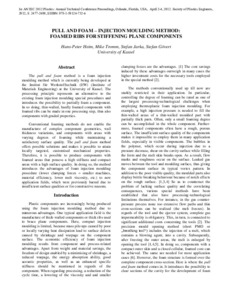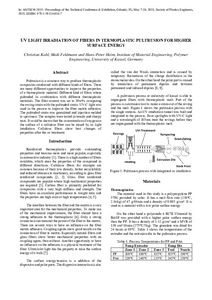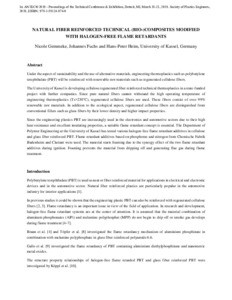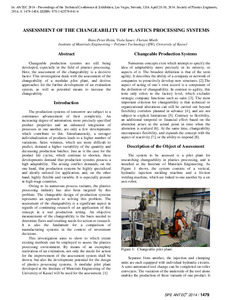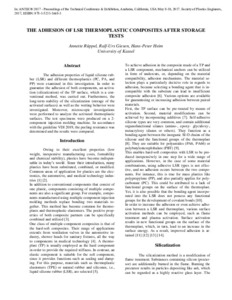Suche
Anzeige der Dokumente 1-10 von 21
Konferenzveröffentlichung

 Influence Of The Fiber-Matrix-Interaction On The Fracture Behavior Of Regenerated Cellulose Fiber Reinforced Polypropylene
Influence Of The Fiber-Matrix-Interaction On The Fracture Behavior Of Regenerated Cellulose Fiber Reinforced Polypropylene
(Society of Plastics Engineers, 2017)
This investigation focuses on the fiber-matrix-interaction of man-made cellulose fibers (RCF) in a PP matrix with an additional MAPP content using an energetic evaluation of the single fiber pull-out test (SFPT). Furthermore glass fibers were characterized for reference purposes. With the SFPT the interfacial shear strength (IFFS) and the critical fiber length (lc) as well as the consumed energy of a fiber pull-out and a fiber rupture were determined. In a following step the resulting values of lc were related to the ...
Konferenzveröffentlichung

 Joining Investigations of Polymer-Metal-Hybrids for Permanantly Non-Leaking Applications
Joining Investigations of Polymer-Metal-Hybrids for Permanantly Non-Leaking Applications
(Society of Plastics Engineers, 2016)
The demand for light-weight construction and economic efficiency has led to the development of light-weight construction strategies, i.e., multi-material design, in many areas of industry. Here, the property profiles of the composite partners are utilized synergetically. Plastic-metal hybrid composites possess a large amount of potential in this regard owing to the weight reduction that can be achieved in the composite and the simultaneous enhancement of the mechanical properties.
Hybrid components have already ...
Konferenzveröffentlichung

 Development of a Flexible Polymer Joining Center Capable of Performing Multiple Joining Processes Using Different Methods in a Single Cycle
Development of a Flexible Polymer Joining Center Capable of Performing Multiple Joining Processes Using Different Methods in a Single Cycle
(Society of Plastics Engineers, 2016)
Goal of this research and innovation project is the implementation of a flexible polymer joining center as a prototype machine integrating different friction welding methods. This prototype joining cell combines (a) flexibility by being capable of performing joining processes in any order in a single flow with (b) modularity by integrating unified interfaces for exchanging joining modules, and (c) scalability by offering a wide range of setups for smaller to larger work pieces. Corresponding interfaces to up- and ...
Konferenzveröffentlichung

 The Influence of different die geometries on the Extrusion Process of High-Consistency Silicone Rubber
The Influence of different die geometries on the Extrusion Process of High-Consistency Silicone Rubber
(Society of Plastics Engineers, 2019)
Silicone Rubber and especially High-Consistency Silicone Rubber (=HCR), are typically processed in the extrusion process. Due to the high requirements in terms of the ma-terial properties and the geometric dimensions, a funda-mental knowledge of the whole process including experi-ences in tool design are essential.
In this study, HCR with different Shore-hardnesses are extruded on a vertical silicone extrusion line with various breaker plates with different length to diameter ratios (=L/D-ratio) in order to analyze ...
Konferenzveröffentlichung

 Pull and Foam - Injection moulding method: Foamed ribs for stiffening plane components
Pull and Foam - Injection moulding method: Foamed ribs for stiffening plane components
(Society of Plastics Engineers, 2012)
The pull and foam method is a foam injection moulding method which is currently being developed at the Institut für Werkstofftechnik (IfW) (Institute of Materials Engineering) at the University of Kassel. The processing principle represents an alternative to the existing foam injection moulding special procedures and introduces the possibility to partially foam a component. In so doing, thin-walled, hardly foamed components with foamed ribs can be made in one processing step, thus also components with graded ...
Konferenzveröffentlichung

 UV light irradiation of fibers in thermoplastic pultrusion for higher surface energy
UV light irradiation of fibers in thermoplastic pultrusion for higher surface energy
(Society of Plastics Engineers, 2018)
Pultrusion is a common way to produce thermoplastic composites reinforced with different kinds of fibers. There are many different opportunities to improve the properties of a thermoplastic material. Different kind of fibers where pultruded in combination with different thermoplastic materials. The fiber content was set to 30wt% comparing the roving strain with the pultruded strain. UV-C light was used in the process to improve the fiber matrix adhesion. The pultruded strain was granulated and injection molded to ...
Konferenzveröffentlichung

 Natural fiber reinforced technical (bio-) composites modified with halogen-free flame retardants
Natural fiber reinforced technical (bio-) composites modified with halogen-free flame retardants
(Society of Plastics Engineers, 2019)
Under the aspect of sustainability and the use of alternative materials, engineering thermoplastics such as polybutylene terephthalate (PBT) will be reinforced with renewable raw materials such as regenerated cellulose fibers.
The University of Kassel is developing cellulose regenerated fiber reinforced technical thermoplastics in a state-funded project with further companies. Since pure natural fibers cannot withstand the high operating temperature of engineering thermoplastics (Ts>230°C), regenerated cellulose ...
Konferenzveröffentlichung

 Assessment of the changeability of plastics processing systems
Assessment of the changeability of plastics processing systems
(Society of Plastics Engineers, 2014)
Changeable production systems are still being developed, especially in the field of plastics processing. Here, the assessment of the changeability is a decisive factor. This investigation deals with the assessment of the changeability of a modular pilot plant, and derives approaches for the further development of an evaluation system, as well as potential means to increase the changeability.
Konferenzveröffentlichung

 The Adhesion of LSR Thermoplastic Composites after Storage Tests
The Adhesion of LSR Thermoplastic Composites after Storage Tests
(Society of Plastics Engineers, 2017)
The adhesion properties of liquid silicone rubber (LSR) and different thermoplastics (PC, PA, and PP) were examined in this investigation. In order to guarantee the adhesion of both components, an activation (silicatization) of the TP surface, which is a conventional method, was carried out. Furthermore, the long-term stability of the silicatization (storage of the activated surfaces) as well as the wetting behavior were investigated. Moreover, microscopic investigations were performed to analyze the activated ...

